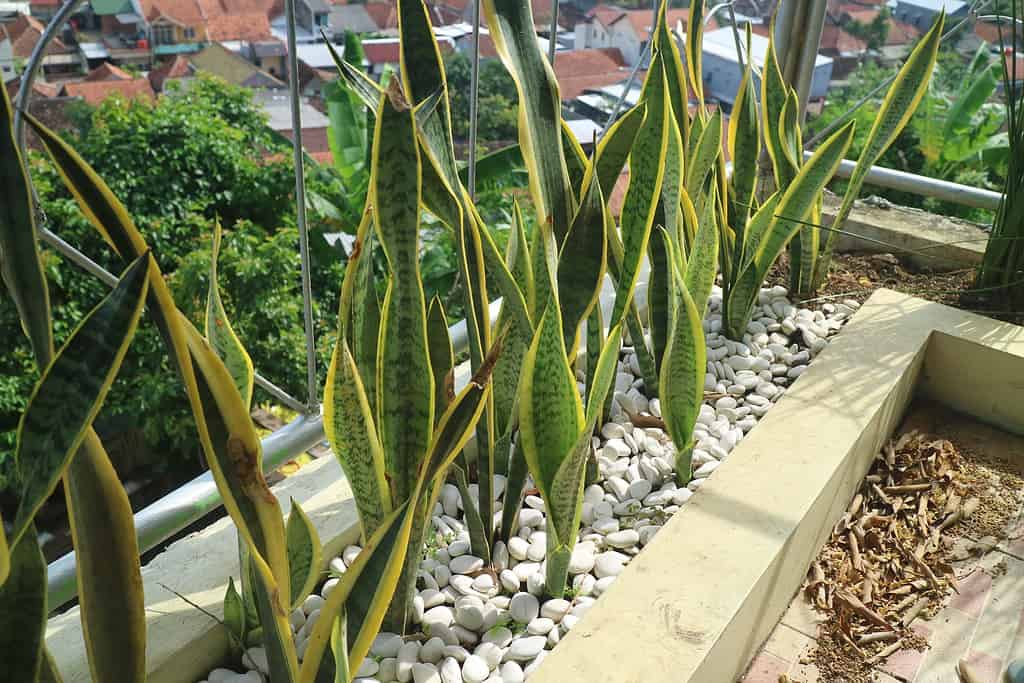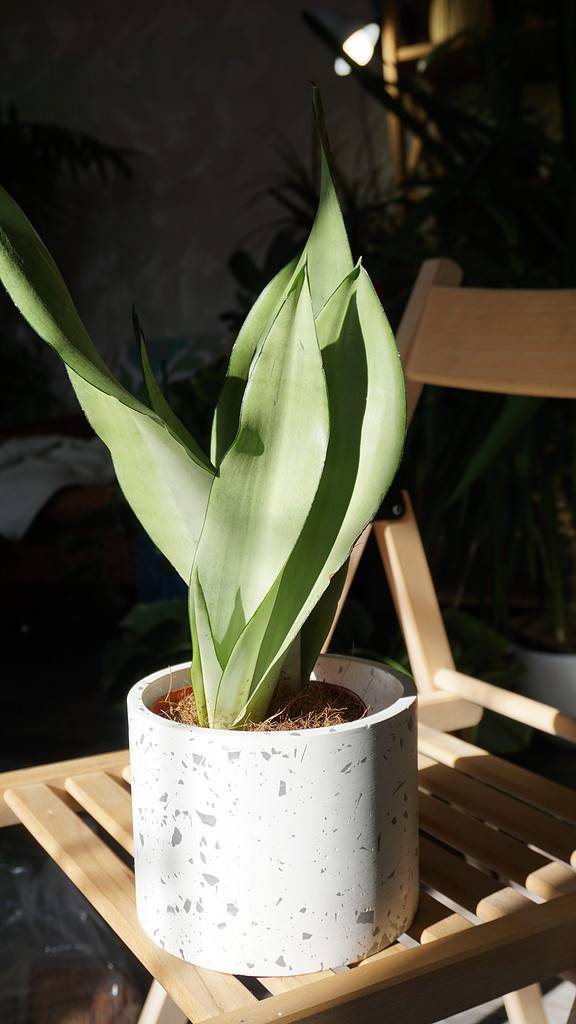I have found one plant above the rest that is excruciatingly tough. A plant that can withstand a small amount of human error. One that allows for mistakes and learning curves. This is the Snake Plant, also known as Saint George’s Sword or Mother-in-law’s Tongue, and sporting sword-like leaves with different color varieties.
Suppose you are anything like me and are not the best at gardening. The snake plant is indestructible whether you are a beginner or need better practice. So, let’s discover what your snake plant needs to thrive!
Snake Plant Stats
| Category | Statistic |
|---|---|
| Scientific Name | Dracaena trifasciata |
| Family | Lily Family |
| Species | 70 different varieties |
| Size | Height: 1-12 feet Width: 6-36 inches |
| Type | Houseplant |
| Color | Grey, Green, Silver, Yellow, Pink |
Saga of the Snake Plant
Getting its start in West Africa, the Dracaena trifasciata has many different cultural connections worldwide. Some places are in Africa, Asia, Brazil, and Australia, and an American 1930s painting, American Gothic.
“Sword-like” is how the leaves on the plant are described. Usually, you will find the leaves to be very stiff, growing straight up towards the sky.
A gold or silver band usually runs along the outer rim of the sticky leaf. Their leaves are where they retain their water so that they can be thick and slimy. Its texture is that of a succulent. This plant usually grows in bundles of three, and you can quickly propagate another plant from a large enough cut leaf.
There are 70 varieties of snake plants in size, shape, and color. The one thing that remains is the sword-like feature of their leaves. Most of the variety of the snake plant species carries this trait. The leaves on this plant vary from narrow to broad. Some are different shades of green, while others have compliments of pink.
Interior Design is the art of turning indoor spaces into works of art, making your living room not just functional in regards to being a living area but being able to look at it in awe of its beauty. Think of any home and garden magazine. The pictures they house of the living spaces do not look like yours and mine, for they are stages, preset by interior designers. However, some people’s homes look like that, beautiful from every corner.
Within these homes, I guarantee you will find several species of the snake plant variety. They are incredibly low maintenance and look stunning. They offer so much to the space they consume. By this, I mean snake plants give us several gifts from their existence.

A snake plant grows healthy and tall in a garden surrounded by stone, which helps provide drainage.
©Adipra/iStock / Getty Images Plus via Getty Images
The Plant Gives
Statistically speaking, the snake plant provides you with better health. I have read so many different theories on what snake plants can do for you and so many people discussing the same thing.
It is unbelievable to think something is so easy to care for AND can provide you with a better life at the same time. All you have to do is buy it, essentially. Not to mention, it is not that expensive of a purchase. Plants are generally pretty justifiable regarding their price.
I want to provide you with a list of all I have found that snake plants can provide. The list was longer than I thought it was going to be:
- Fung Shey
- Better air quality
- Removes air pollutants
- Filters out ammonia
- Boosts mental health
- Produces oxygen at night
Providing the Care
I have found that the term low maintenance is the best description of this plant. Every place you find that has written about this plant deems it as such. Attention-seeking behaviors aside, this plant almost absolutely does not need you. The care you need to keep it alive will be minimal!
Regardless, it will be a stunning piece to add to your home. Changing the look of your home entirely, Snake plants make things look better. Caring for a snake plant is not as complicated as you would assume.
Sunlight
Snake plants like the shade. They are a shady species, but they do not mind some sun. Some indirect sunlight is good for them. It helps wake them up and feeds them for proper growth. But they do not need it for the long term.
They also do not mind a little time spent in direct sunlight, not too much, though, as they can burn up quickly. While moving them from different areas of light, from shady to bright, do it slowly. Moving a plant’s light source too fast can shock them. Their movement needs to be gradual.

Sitting a snake plant briefly in the direct sunlight is okay; do not forget them there!
©Kseniia Plakhtii/iStock / Getty Images Plus via Getty Images
Water
Not to be confused with a cacti, the snake plant is said to be able to withstand a drought. This is due to its succulent properties and ability to collect water in its foliage. As long as its leaves are full, this plant can last long without being watered. Keep in mind the length of the foliage. The longer the leaves, the more water will be retained.
When caring for your snake plant, you will treat it as a succulent, letting its soil completely dry before watering it again. About every 2-3 days, depending on the plant and pot size.
Plant Addicts say if you notice the “foliage fading, yellowing, browning, and especially turning crispy,” that indicates that your snake plant needs a drink.
This is one of the significant areas to pay close attention to when caring for your snake plant. With a feeding schedule of every couple of days, it is easy to forget and not provide the proper amount of water needed to sustain its life. If its soil is hard and compacted, this is a sign that it might not be receiving the adequate amount.
Just like you can not water it enough, you can overwater your plant, causing significant damage.
Soil
Readers Digest explains root rot as “several fungal and related disease-causing organisms that enter a plant’s roots. These pathogens gain a foothold when roots are in water-soaked conditions.”
When a plant consumes too much water and does not have a place to displace it, the roots of the plant can rot. This essentially will cause your plant to decay.
Snake plants are prone to root rot for several different reasons. Overwatering is the number one reason. They are a plant that does not require much water to stay alive. Not only that, but they do not need to be watered as frequently as other house plants do. When you care for your snake plant, please give them the proper amount of water, and ensuring their soil is adequately maintained is a good start.
As snake plants are more succulent-based when growing indoors, it would be beneficial for you (and your plant) to use succulent soil. These types of soil are a mixture of soil, moss, and gravel, that is, things that will help you receive the maximum amount of draining potential. Succulent soil provides your snake plant with the proper amount of aeration. It also has the best nutrients blended in that your desert-like plant species would want.
Also, note the size of your plant and the size of your pot. If your pot is too large, there will be a water drainage issue. If the pot is too small, the plant will not have enough room to consume enough water, nor will it have enough room to grow bigger.
Both of these issues look towards maintaining root rot. Another head nod toward its low maintenance style. Root rot is the biggest issue when working with this plant. Keep it wet enough to drink but dry sufficiently so it does not get a rash and no chafing. If chafing occurs, you need a different pot.
Buyer Beware
As a low-maintenance plant, the snake plant is known to grow incredibly slowly. The plant’s roots need ample space to evolve for proper growth. When this plant is placed in a pot indoors, it does not grow to its total capacity in the time it should. Therefore, you must frequently prune this plant to keep it growing correctly.
This plant is prone to fungus. When caring for your snake plant, you will constantly be fighting off the growth of this bacteria. It is crucial to the plant and its pot that they are kept clean and that there is no standing water.
Another thing that needs to be mentioned is the temperature this plant likes to be kept in. Snake plants prefer areas that are cool in temperature. Not too hot, but not too cold. The goldilocks of plants.
Lastly, the snake plant is known to be toxic if ingested or chewed! If you have pets, specifically cats, and young children you might want to take a risk assessment before bringing this plant into your home. Cats, primarily, are known for chewing on and consuming houseplants. As your cat, destroying your plant-like creatures is in their nature. If you have ever owned a cat, you know. This is not to say a dog could or would not consume a plant as well. Lizards will try, so if you own a reptile for a pet, definitely keep them away from your snake plant.
Other Resilient Plants
Snake plants are not the only plants with a strong backbone. Some other plants that are known to be pretty tough are:
- Pothos, aka Devil’s Ivy (Epipremnum aureum)
- Philodendron (Philodendron erubescens)
- Split-leaf philodendron aka Swiss Cheese Plant (Monstera deliciosa)
- ZZ plant (Zamioculcas zamiifolia)
- Spider Plant (Chlorophytum comosum)
You can find more articles here for other information on growing resilient plants.
Thank you for reading! Have some feedback for us? Contact the AZ Animals editorial team.








